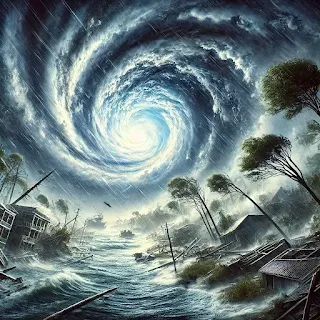Hurricanes are among the most destructive natural disasters, leaving devastation in their wake with powerful winds, flooding, and storm surges. Throughout history, some hurricanes have stood out due to their overwhelming impact on human life, infrastructure, and economies. Here is a list of the top 10 worst hurricanes, focusing on why they were so catastrophic.
1. Hurricane Katrina (2005)
- Location: U.S. Gulf Coast (primarily New Orleans)
- Why It Was Devastating:
- Loss of Life: Over 1,800 deaths.
- Economic Damage: Over $160 billion in damage, making it the costliest hurricane in U.S. history.
- Flooding: Levee failures in New Orleans caused 80% of the city to flood.
- Displacement: Hundreds of thousands of people were displaced, some permanently.
Hurricane Katrina’s deadly storm surge, the failure of flood defenses, and the delayed emergency response compounded the disaster’s scale.
2. Galveston Hurricane (1900)
- Location: Galveston, Texas, USA
- Why It Was Devastating:
- Loss of Life: Estimated 6,000 to 12,000 deaths, the deadliest natural disaster in U.S. history.
- Storm Surge: A 15-foot storm surge submerged the island, destroying nearly every structure.
- Lack of Warning: There was minimal warning and preparedness, amplifying the tragedy.
The Galveston Hurricane struck at a time when meteorological technology was limited, leaving residents with little preparation.
3. Hurricane Mitch (1998)
- Location: Central America
- Why It Was Devastating:
- Loss of Life: Over 11,000 people died, with thousands more missing.
- Rainfall and Flooding: Mitch stalled over Central America, dumping up to 75 inches of rain, causing landslides and massive flooding.
- Economic Impact: Entire towns were swept away, and the infrastructure in Honduras and Nicaragua was destroyed, taking decades to recover.
Mitch’s slow movement and enormous rainfall caused unprecedented flooding and landslides, making it one of the deadliest Atlantic hurricanes.
4. Bhola Cyclone (1970)
- Location: East Pakistan (now Bangladesh)
- Why It Was Devastating:
- Loss of Life: Up to 500,000 deaths, making it the deadliest tropical cyclone ever recorded.
- Storm Surge: The cyclone caused a 20-foot storm surge that wiped out coastal villages.
- Political Impact: The devastation contributed to political unrest in Pakistan, which eventually led to the independence of Bangladesh.
The Bhola Cyclone’s combination of a massive storm surge, densely populated areas, and limited disaster preparedness led to an overwhelming loss of life.
5. Hurricane Maria (2017)
- Location: Puerto Rico, Dominica, and U.S. Virgin Islands
- Why It Was Devastating:
- Loss of Life: Estimated 2,975 deaths in Puerto Rico alone, with many deaths attributed to the aftermath.
- Infrastructure Collapse: The storm destroyed much of Puerto Rico’s power grid, leaving residents without electricity for months.
- Economic Damage: Over $90 billion in damages, making it one of the costliest hurricanes in U.S. history.
Hurricane Maria’s high winds and flooding caused a humanitarian crisis, worsened by delayed federal aid and the pre-existing economic struggles of Puerto Rico.
6. Hurricane Andrew (1992)
- Location: Florida and the Bahamas
- Why It Was Devastating:
- Loss of Life: 65 deaths.
- Economic Damage: $27 billion in damage, making it the most expensive hurricane in U.S. history at the time.
- Wind Speeds: Sustained winds of up to 165 mph flattened neighborhoods in South Florida.
Hurricane Andrew’s ferocious winds destroyed thousands of homes, leaving many homeless and causing the restructuring of building codes in Florida.
7. Hurricane Irma (2017)
- Location: Caribbean, Florida, and southeastern U.S.
- Why It Was Devastating:
- Loss of Life: 134 deaths.
- Economic Damage: $77 billion in damages.
- Size and Strength: One of the strongest Atlantic hurricanes on record, Irma maintained Category 5 strength for three consecutive days.
Irma caused widespread destruction across multiple regions, from the Caribbean islands to the southeastern U.S., with its sheer size and powerful winds.
8. Hurricane Harvey (2017)
- Location: Texas and Louisiana
- Why It Was Devastating:
- Loss of Life: 107 deaths.
- Rainfall: Harvey set the record for the most rainfall in a single storm, dumping over 60 inches in parts of Texas.
- Economic Damage: Over $125 billion in damages.
The flooding from Hurricane Harvey caused catastrophic damage, with entire neighborhoods submerged for days, and thousands of people displaced.
9. Hurricane Ike (2008)
- Location: Caribbean, Texas, Louisiana
- Why It Was Devastating:
- Loss of Life: 195 deaths.
- Economic Damage: $38 billion in damages.
- Storm Surge: Ike produced one of the largest storm surges ever recorded, devastating the Texas coastline and Galveston Island.
Ike’s storm surge and massive size led to widespread destruction, even affecting areas far from its center.
10. Great Hurricane of 1780
- Location: Caribbean
- Why It Was Devastating:
- Loss of Life: Estimated 22,000-27,000 deaths, the deadliest Atlantic hurricane in recorded history.
- Impact on War: The hurricane disrupted naval operations during the American Revolutionary War, sinking ships and killing sailors.
- Destruction: Entire Caribbean islands were flattened, and the sheer death toll from this storm remains unparalleled.
The Great Hurricane of 1780 struck at a time when there was no forecasting, and its immense power led to catastrophic loss of life across multiple Caribbean islands.
Conclusion
These hurricanes were not only deadly because of their wind speeds but also due to factors like storm surge, rainfall, and the lack of preparedness in the affected regions. The human toll, economic damage, and long-lasting impacts on infrastructure make these storms the worst in recorded history. Preparedness, better forecasting, and improved infrastructure have become essential lessons learned from these tragedies.


No comments:
Post a Comment
Note: Only a member of this blog may post a comment.